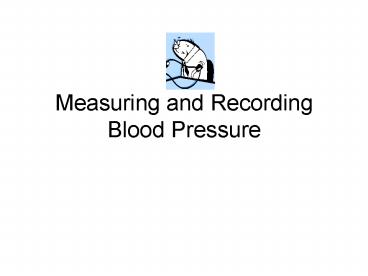Measuring and Recording Blood Pressure - PowerPoint PPT Presentation
1 / 23
Title:
Measuring and Recording Blood Pressure
Description:
S/S of Hypotension Dizziness Clammy Skin Cool Skin Nausea Light-Headed Feeling Faint Black-Out Orthostatic Hypotension Postural hypotension-occurs when there is a ... – PowerPoint PPT presentation
Number of Views:405
Avg rating:3.0/5.0
Title: Measuring and Recording Blood Pressure
1
Measuring and Recording Blood Pressure
2
Blood Pressure-BP
- Measurement of pressure that the blood exerts on
the artery walls during the various stages of
heart activity. - Measured in mmHg on instrument called a
sphygmomanometer. (blood pressure cuff) - http//www.youtube.com/watch?vqWti317qb_w
3
Two types of BP
- Systolic-first beat heard
- Top number
- Diastolic-last beats heard
- Bottom number
4
Systolic Pressure
- Systolic pressure occurs in artery walls when the
Left Ventricle of the heart is contracting and
pushing blood into the arteries. - Normal systolic reading is 120 mmHg
- Normal range is 100-140 mmHg
5
Diastolic Blood Pressure
- Diastolic pressure-constant pressure in artery
walls when Left Ventricle of heart is at rest or
between contractions. - Volume of blood in arteries has decreased.
- Normal reading 80mm/Hg
- Normal range 60-90 mm/Hg
6
Pulse Pressure
- Difference between systolic and diastolic
pressure - Normal range in adults is 30 to 50 mm/Hg.
- Example Systolic pressure is 120 mm/Hg and
diastolic pressure is 80 mm/Hg, the pulse
pressure is 40 mm/Hg. (120-8040)
7
HYPERTENSION
- High blood pressure
- When pressures are greater than
- 140 mm/Hg systolic and 90 mm/Hg
- diastolic
- Common Causes stress, anxiety, kidney disease,
aging, high-salt intake, thyroid deficiency, and
vascular conditions, life style choices
8
- Controllable Factors
- Diet, exercise, smoking habits, stress
- Uncontrollable Factors
- Age, sex, family history
9
Effects of HypertensionCalled the Silent Killer
- Causes damage to the arteries, weakens them, Can
cause aneurysmDeath - Heart Enlarged Heart, Heart Failure, MI, Heart
Disease - Brain Stroke, Dementia
- Kidneys Kidney Failure
- Eyes Blindness
10
S/S of Hypertension
- Headache
- Ringing in the Ears
- Nosebleed
- Blurred vision
- Seeing Spots
11
HYPOTENSION
- Low blood pressure when pressures are less than
100 mm/Hg systolic and - 60 mm/Hg diastolic.
- Common Causes heart failure, hemorrhage,
dehydration, depression, severe burns, trauma.
12
S/S of Hypotension
- Dizziness
- Clammy Skin
- Cool Skin
- Nausea
- Light-Headed
- Feeling Faint
- Black-Out
13
Orthostatic Hypotension
- Postural hypotension-occurs when there is a
sudden drop in both systolic and diastolic
pressure. - This occurs when the individual moves from a
lying to a sitting or standing position. - Caused by inability of blood vessels to
compensate quickly to the change in position.
14
Various Factors Influences BP Readings
- Force of heartbeat
- Resistance of the arterial system
- Elasticity of the arteries
- Volume of the blood in arteries
15
Various Factors CausingIncreased BP
- excitement, anxiety, nervous tension
- Exercise and eating
- Smoking
- Drugs, Alcohol
16
Various Factors Causing Decreased BP
- Rest or sleep
- Depressant drugs
- Shock
- Excessive loss of blood
- Fasting
17
Factor that may cause changes
- Lying down
- Sitting position
- Standing position
18
Recording BP
- Record as a fraction.
- Systolic is the top number
- Diastolic is the bottom number
- 120/80
19
Two main types of sphygmomanometers
- Mercury sphygmomanometer-has long column of
mercury - Each mark represents 2 mmHg.
- Aneroid has round gauge
- Cuff deflatedzero for accuracy
- Electronic types used in healthcare facilities.
20
Recommendations
- AHA-American Heart Assn. recommends pt. sit
quietly for _at_ least 5 min. before taking BP. - AHA recommends that two readings be taken,
averaged, with a minimum wait of 30 seconds
between readings. - Pt. seated or lying comfortably with forearm
supported on flat surface.
21
Procedure
- Cuff appropriate size for pt.
- Arm free of restrictive clothing
- Deflated cuff should be placed on arm with center
of cuff directly over the brachial artery. - Lower edge of cuff should be 1-1 ½ inches above
the bend of the elbow.
22
Rest of the procedure
- Final point-accuracy in placing stethoscope bell
or diaphragm directly over the brachial artery at
the antecubital area (bend in the elbow). - Hold securely but with slight pressure.
23
Do not use
- Arm with IV
- Arm with paralysis
- Arm on side which pt has had a mastectomy
- Arm that has a Dialysis shunt































![get [PDF] DOWNLOAD blood pressure log book pocket size: small diary fo PowerPoint PPT Presentation](https://s3.amazonaws.com/images.powershow.com/10086130.th0.jpg?_=20240726065)